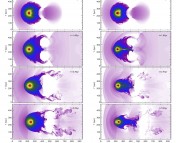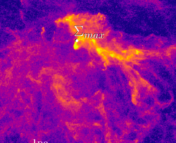Title: The Signature of Large Scale Turbulence Driving on the Structure of the Interstellar Medium
Authors: Tine Colman, Jean-François Robitaille, Patrick Hennebelle, Marc-Antoine Miville-Deschênes, Noé Brucy, Ralf S. Klessen, Simon C. O. Glover, Juan D. Soler, Davide Elia, Alessio Traficante, Sergio Molinari, Leonardo Testi
First Author’s Institution:
Status: Accepted for Publication in MNRAS [open access]
It sure would be great if we understood more about turbulence. The chaotic fluid motions that we broadly call turbulence are widespread throughout the gas of the interstellar medium, and yet our description of how the evolution of these turbulent systems influences star formation and galaxy dynamics is still pretty limited. Turbulence is usually a transient process – the kinetic energy within those chaotic gas motions cascades down to smaller and smaller spatial scales until eventually it is dissipated away by the gas’s viscosity. So if its energy decays away in this cascading process relatively quickly (at least relative to the million-ish year timescales typical for many other interstellar processes), why is it that we see so much turbulence out there in interstellar gas? Shouldn’t it have all decayed away already? There’s only one possibility: something must be continuously creating more turbulence.
So what could be responsible for the constant stirring of the cosmic pot? The authors of today’s paper grapple with this very question, investigating whether the limits of our current understanding of the commonplace physics of the interstellar medium is sufficient to sustain its turbulent properties.
If turbulence is such a challenging property to pin down and quantify, how could you figure out something as specific as where it came from? To figure out what’s driving turbulence in the interstellar medium, we can look at the statistical properties of the gas. The Power Spectrum is a particularly powerful and frequently used statistical tool, which (in this case) describes the amount of coherent structure at different spatial scales. For instance, if a density map of a cloud has a lot of long gas filaments, it will display a different power spectrum from a cloud that’s made up of tiny, isolated clumps of gas.
The authors set out to benchmark how different types of turbulent driving affect the power spectrum of the column density of the interstellar medium by running hydrodynamic simulations of the disk of a galaxy. These simulations follow the evolution of a 1 kiloparsec box as gas flows form filamentary structure, full of supersonic shockwaves, and eventually form stars. The simulations also allow stars to form within those gas structures, and sufficiently massive stars can provide stellar feedback in the form of supernovae and ionizing radiation. This stellar feedback produces some turbulence in the gas over time, but the authors also include a more generalized and larger scale turbulent driving, stirring the gas with different intensity in different runs of the simulation to see how they differently affect the resulting power spectra. This artificial turbulence is meant to represent larger-scale (up to the full size of the 1 kiloparsec box) forces that might be important in influencing the evolution of gas on smaller scales.
In order to extract more useful information about the turbulent properties, the authors explore decomposing the simulated cloud into two components: a fluffy, diffuse component, and a more coherent network of filaments and dense clumps which shows more extreme differences under different turbulent conditions. An example of the density maps from these simulations, and the corresponding decomposition into fluffy and coherent components is shown in Figure 1.
The authors then compare the power spectrum from their collection of hydrodynamic simulations with different types of injected turbulence conditions to some real observations from the Herschel Space Observatory of the Large Magellanic Cloud (called the LMC for short), one of the Milky Way’s satellite galaxies. This relatively nearby target happens to be a great comparison for the region generated by the authors’ simulations in terms of physical resolution. In order to have a more suitable sample of similar boxes to the simulations, they divide up the LMC into 25 subregions, shown and labeled in Figure 2. The power spectra that they calculate from the simulations in comparison to a subset of the different subregions of the LMC are shown in Figure 3, where some fascinating trends emerge!
It seems that, first of all, the simulation that doesn’t include the larger-scale driving (and only contains the turbulence created by stellar feedback) fails to resemble the power spectrum in nearly all of the LMC subregions. Clearly, stellar feedback is not enough to create the types of turbulence seen in the real interstellar medium. It seems that most of the observed regions in the LMC require some sort of larger-scale turbulent driving, and in some cases seem to exhibit turbulence driven on scales larger than a kiloparsec. It’s unclear what’s generating such large-scale turbulence, though the presence of supergiant shells (the catastrophic results a clustered burst of supernovae explosions), or gravitational interactions with the galaxy’s distribution of stars (like a stellar bar, for instance) are possible contenders for stirring up the interstellar medium on galactic scales.
Astrobite edited by Suchitra Narayanan
Featured image credit: Figure 4 from today’s paper




